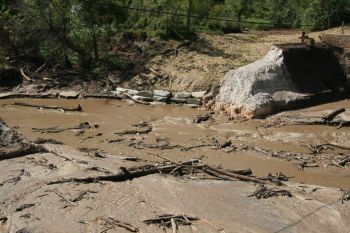Breach Scenarios

|
| Pigg River Power Dam Breach.
(Image Source: Wikimedia) |
“Typically, several hydrologic and non-hydrologic (fair weather) events are evaluated as part of an event-based dam safety analysis. For hydrologic failure events, an extreme flood event ranging from the 50-year event for low-hazard dams up to the PMF for high-hazard dams is selected based on the potential for loss of life due to a dam failure or for significant economic and environmental losses. Typically the hazard potential classification of the dam is used to selecte the extreme hydrologic failure event. The PMF is the flood that may be expected from the most severe combination of critical meteorological and hydrologic conditions that are reasonably possible in the drainage basin under study. The Probable Maximum Precipitation (PMP) is an estimate of the maximum possible precipitation depth over a given size catchment for a given length of time (Stedinger et al., 1996).
“A fair weather (Sunny Day) breach is a dam failure that occurs during fair weather (i.e. non-hydrologic or non-precipitation) conditions. A fair weather breach is analyzed by establishing an initial reservoir water level and commencing a breach analysis without additional inflow from a storm event. A fair weather breach is typically used to model piping failures for hydrologic, geologic, structural, seismic, and human-influenced failure modes.
“Base flow conditions for a fair weather failure are typically ignored because of the small discharge and volume compared to that of a dam breach. As a general guidance, base flow can be ignored if the dam breach flow is two times greater than the base flow. Where base flow is considered, the discharge is typically estimated based on reported base flows through the dam’s outlet works or from stream gage records. The three most common initial water level elevations for fair weather breach analyses are as follows:
- “Normal Pool Elevation (invert of the highest elevation of the primary outlet): A breach at the normal pool elevation of the reservoir is used to estimate the volume and associated breach discharge that would result from a failure event during fair weather conditions. For an embankment dam, this type of event is modeled as piping/internal erosion failure, whereas for a concrete dam, this event is modeled as a monolith collapse resulting from sliding, foundation instabilities, or a seismic event.
- “Invert of Auxiliary Spillway (lowest uncontrolled spillway): A breach of the dam with the reservoir water level set at the auxiliary spillway (also referred to as an emergency spillway) is common practice to simulate a breach during misoperation of the primary outlet works. Initiation of dam failure is typically the same as for the reservoir level at normal pool.
- “Top of Dam / Maximum High Pool: The reservoir level set to the top of the dam to represent the maximum amount of volume that may be stored in the reservoir. This condition may be selected to evaluate the most conservative non-hydrologic event. In practice, dams without adequate spillways or pump storage facilities, where the water level during non-hydrologic events is maintained at the top of the dam, are unique situations subject to this conservative assumption. A breach event when the water level is at the top of the dam may be modeled as a piping/internal erosion failure or as an overtopping failure with the water level just above the top of dam invert.
“Various Federal agency publications provide guidance for establishing the initial water surface elevation of a reservoir during a fair weather failure event. Each of these specified elevations is used to characterize different failure modes as well as the potential volume of the reservoir at the time of failure” [1].
Best Practices Resources
Citations:
Revision ID: 7401
Revision Date: 07/21/2023
